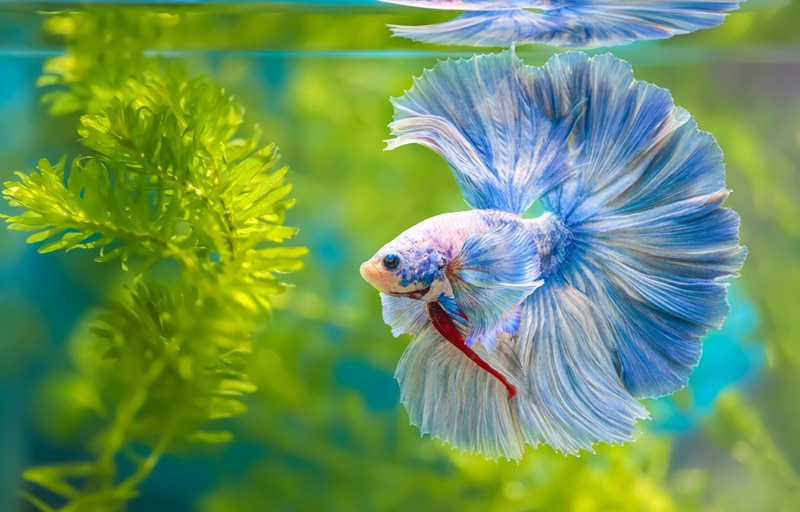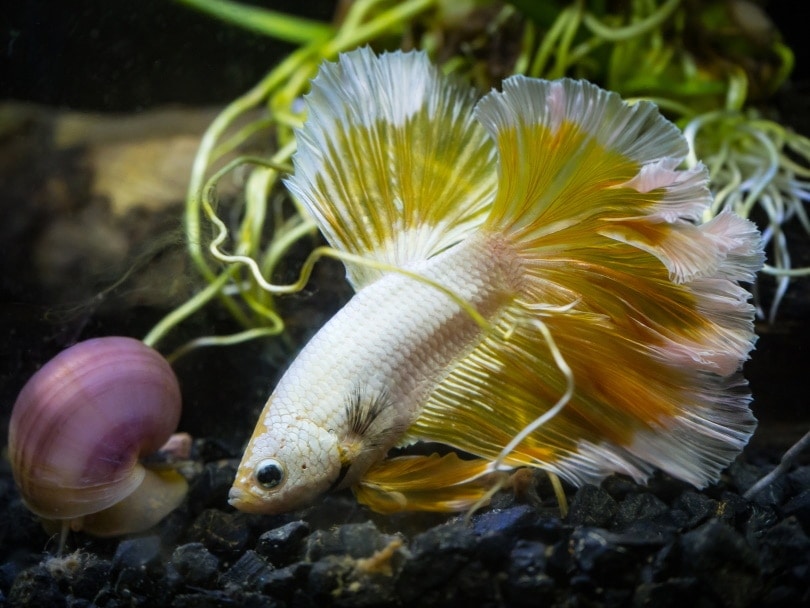Rosetail Betta Fish (Rose Petal): Care Guide, Pictures, Lifespan & More
Updated on

Click to Skip Ahead
In the world of Betta fish, there are dozens of varieties to choose from. They come in all kinds of colors and eye-catching fin shapes. One of the most eye-catching fin shapes seen in Betta fish is the tail fin of the Rosetail Betta. However, these fish are surrounded by controversy and questions over the ethics of breeding them. If you are interested in purchasing a Rosetail Betta, keep reading for all the information you need about them, including why they’re so controversial.
Quick Facts about Rosetail Betta
| Species Name: | Betta splendens |
| Family: | Osphronemidae |
| Care Level: | Moderate |
| Temperature: | 72–82˚F |
| Temperament: | Semi-aggressive |
| Color Form: | Any color form |
| Lifespan: | 2–5 years |
| Size: | 1–2.5 inches |
| Diet: | Carnivorous |
| Minimum Tank Size: | 5 gallons |
| Tank Set-Up: | Tropical freshwater planted tank |
| Compatibility: | Invertebrates too large to be considered prey |
Rosetail Betta Overview

The Rosetail Betta fish is a variant of the Half-moon Betta. They are bred to have a tail that has a full 180˚ spread. Originally, Rosetail Bettas were considered an unwanted mutation of the Half-moon. They were considered to be cull-quality fish and were not intentionally bred for.
The Rosetail Betta initially started showing up as an intentionally bred variety of Betta fish in 1989, so they have been in the pet trade for over 30 years. The reason that they were not originally bred intentionally is that there are multiple problems associated with these fish. They tend to have low spawn rates, which can make breeding them difficult, but that is the least of their problems.
The shape of their fins makes them susceptible to broken fin rays, which can not only lead to misshapen fins but difficulty swimming and discomfort and pain for the fish. Their tails are also excessively heavy in relation to their body size, which only makes swimming more difficult. Some Rosetail Bettas are known to suffocate if they become too ill or weak to swim to the surface for air.
Rosetail Bettas also have a higher chance of problems with their immune system compared to most other types of Bettas. It’s also extremely common for them to develop fin-nipping and bullying behaviors at a higher rate than those of other Betta fish.
How Much Do Rosetail Betta Cost?
Typically, you can expect to pay $20–$25 for a Rosetail Betta fish. However, they are often not available in stores due to the ethical concerns associated with them, so you will likely have to order from an online source. When ordering live fish online, expect to spend around $30 or more on shipping to ensure they get to you safely.
Typical Behavior & Temperament
Rosetail Bettas are beautiful but not particularly nice fish. They seem to be frustrated by the weight of their tail and are generally more prone than other Bettas to become bullies. This is saying a lot considering most male Bettas are semi-aggressive to aggressive. In the case of Rosetails, even the females tend to be more aggressive than most other female Bettas. Rosetails are known to be fin-nippers and all-around tank bullies.

Appearance & Varieties
Rosetails are bred to have the same 180˚ tail spread that Half-moon Bettas have. They have fin rays that are more spaced out than Bettas with smaller tail spreads. This allows the full spread of the tail, and they are bred to have a tail that is shaped like a rose when fully extended. Their tails are flowy, delicate, and exceptionally beautiful. Rosetail Bettas are available in just about any color morph that other Betta varieties are available in.
How to Take Care of Rosetail Betta
Habitat, Tank Conditions & Setup
Aquarium Size
Like most Betta fish, Rosetails need at least 5 gallons of tank space to feel safe and comfortable. They need plenty of places to rest and hide while still having open swimming space.
Water Temperature & pH
Although they can survive temperatures from 72–82˚F, Rosetail Bettas do best with stable temperatures in the 78–80˚F range. They prefer a slightly acidic to mostly neutral pH between 6.5–8.0. The biggest part of their pH needs is to ensure the pH is stable.

Substrate
Bettas will pick things up from the tank floor, but they aren’t big scavengers, so they typically don’t seem to care much about substrate. Choose a substrate that can support live plants and that is not sharp to avoid tearing your Bettas fins.
Plants
Your Betta needs a tank with live plants. They appreciate plants with large leaves they can rest on, like Anubias and Java Fern. They also like dense floating plants they can spend time in, like Water Sprite, and plants with trailing roots, like Dwarf Water Lettuce.

Lighting
The biggest consideration for your Betta’s lighting is to provide a regular day/night cycle and a light that is powerful enough to support plant life.
Filtration
Bettas in general are not great swimmers, and Rosetail Bettas are worse swimmers than most. They need a filter that is strong enough to keep the tank oxygenated and clean, but not so strong that it impedes swimming. Sponge filters and filters with baffles are good options for Betta tanks.
Are Rosetail Betta Good Tank Mates?
In general, Rosetail Bettas are not good tank mates. They are definitely not good tank mates for other fish due to their grumpy, fin-nipping nature. If you intend to keep a sorority or a single female in a community tank, this may work, but these females may have more semi-aggressive tendencies than other types of female Bettas.
Ideal tank mates for Bettas are animals that will not be bothered by their nipping and bullying. Mystery snails are a good tank mate option because they are large enough to not be hurt by your Betta fish. Some bottom dwellers, like some varieties of Plecos, are also good tank mates since they will rarely cross paths with your Betta and their armored scales make them less susceptible to injury from nipping and bullying.
What to Feed Your Rosetail Betta
Like other Bettas, Rosetail Bettas are carnivores. They require a high-protein diet that should have a high-quality Betta or carnivore pellet as its base. They can also be offered thawed frozen or live foods, like bloodworms and red wigglers, as treats. These do not contain all nutrients necessary to keep your Betta healthy, though, which is why a commercial diet is necessary.
Betta fish do not need plant matter in their diet. Do not offer them veggies or fruits as this can lead to malnutrition and illness. Peas are often recommended as a treatment for constipation in fish, but this isn’t a good idea for Bettas due to their carnivorous nature. Usually, constipation is best treated by fasting.

Keeping Your Rosetail Betta Healthy
Rosetail Bettas are at risk for fin injuries and illnesses. The most common problem seen in Rosetails is broken fin rays, which can lead to difficulty swimming and pain. They may be especially susceptible to water quality problems as well since their immune system is often depressed. Maintaining high water quality and providing a high-quality diet are the most important things you can do to keep your Rosetail Betta healthy.
Also, ensure that the water flow in the tank is adequate without being too strong. Rosetails have more difficulty swimming than most Betta fish. They can become weighed down or worn out easily due to their tail fins. Rosetails may live shorter lives than other Bettas, even with great care, due to their poor breeding quality.

Breeding
Due to the ethical concerns with these fish, breeding them in the home aquarium is not recommended. Because of their susceptibility to health and swimming problems, these fish should only be bred by people who fully understand their needs. Even in the case of professional breeders, continuing to breed Rosetail Bettas is ethically questionable.
Are Rosetail Betta Suitable For Your Aquarium?
Rosetail Bettas are gorgeous fish that can draw attention to the smallest tank. However, there are better options available. Bettas are available in tons of varieties, all of which are beautiful in their own way. Continuing to breed fish that we know are physically and genetically susceptible to problems is unethical and can lead to painful and uncomfortable lives for the fish themselves.
If you are dead set on acquiring a Rosetail Betta, ensure you are purchasing from someone who has had great success with breeding Rosetails with little to no problems related to swimming, immunity, or behavior. Honestly, you may not be able to find this since these fish are so susceptible to problems.
Featured Image Credit: panpilai paipa, Shutterstock














